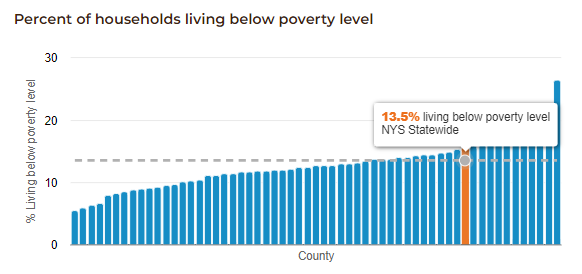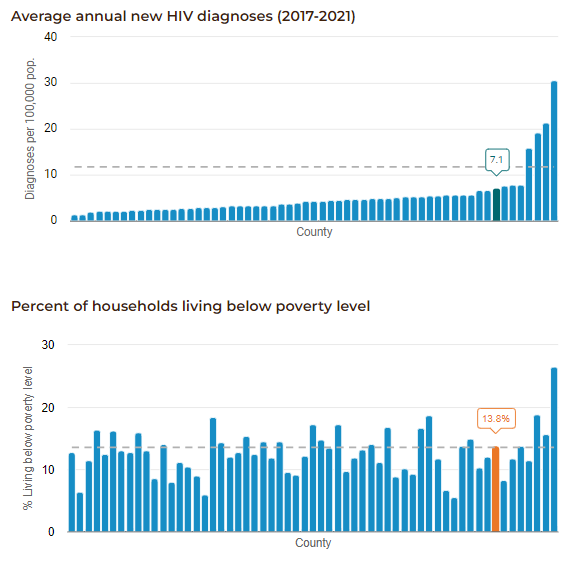Social Determinants of Health and HIV Outcomes
By ETE Dashboard |
December 4th, 2023 |
Categories:
|Tags:
|0 Comments
Last week the ETE Dashboard launched a new data visualization featuring social determinants of health (SDOH) alongside HIV-related outcomes by county in New York State. This new interactive tool allows users to compare ETE metrics such as new diagnoses rates and viral suppression with social and economic measures like poverty, education level, and housing cost. In presenting these data together on the Dashboard, we aim to highlight the importance of how structural and social inequities where people live are associated with key disparities in HIV-related outcomes.
What are SDOH and why do they matter?
SDOH are the nonmedical factors that influence various health outcomes, encompassing the conditions in which people are born, grow, work, live, and age, and the systems shaping the conditions of daily life. These systems include economic policies, development agendas, social norms, social policies, racism, climate change, and political systems.[1] Persistent inequities related to SDOH often overlap and in some cases increase health risks and limit access to key resources and opportunities essential for prevention and sustained HIV care.
While we know from looking at surveillance data that HIV has a disproportionate impact on some communities, examining factors like poverty, education, insurance status and housing may help us better understand why these disparities persist and reinforce the need to look more broadly at all the conditions that impact our work to end the HIV epidemic. In regional community listening sessions convened by the NYS DOH AIDS Institute on setting priorities for ETE beyond 2020, community members expressed the need for increased focus on health inequities and social determinants of health. Stakeholders further highlighted “home and food insecurity, lack of transportation, language, and lack of access to technology and education as main barriers to health care.”[2]

How to use the visualization
The four HIV indicators included in this visualization are new HIV diagnoses, prevalence of diagnosed HIV, viral suppression among people living with diagnosed HIV, and deaths among people with HIV.[3] Five SDOH indicators are available, including household poverty, education level, health insurance status, housing cost burden, and food insecurity, sourced from the U.S. Census Bureau’s American Community Survey (ACS) 5-year estimates, with the exception of food insecurity. See the SDOH data visualization page notes for all indicator definitions.
Users have the option of viewing SDOH and HIV data either in a bar chart or map. In the chart view (see image below on the left) each county’s data is displayed along the x-axis (i.e. horizontally), with the topchart showing HIV data and the bottom chart directly below displaying the SDOH data, corresponding in the same county order. Users can use the filter menu to select any one of the HIV or SDOH indicators to display and sort the county order by either HIV or SDOH data (see image below on the right). These visualizations provide a snapshot of county level data in New York State and while some of these outcomes may be correlated, data should be interpreted with caution as further analyses would be needed to assess any associations or potential causal relationships between individual SDOH and HIV measures.


The map view displays the same data, but on a two-layered map, with one layer symbolizing the SDOH variables as circles sized proportionally to the data (i.e. graduated symbols) while the other layer uses color shading to visualize variation in HIV data, also known as a choropleth map.

These data visualizations can provide useful context on the broader societal forces that impact and shape the HIV epidemic in New York State and will hopefully serve as a springboard for deeper examination of the social and structural factors that uphold and potentially exacerbate disparities across many of the official ETE Metrics.
Stay tuned for future ETE Dashboard updates related to SDOH and health disparities in the coming months!
[1] SDOH as defined by the CDC and WHO.
[2] Ending the Epidemic Beyond 2020 – Addendum Report: https://www.health.ny.gov/diseases/aids/ending_the_epidemic/docs/ete_beyond_2020_report.pdf
[3] Data source: NYS HIV Surveillance System
